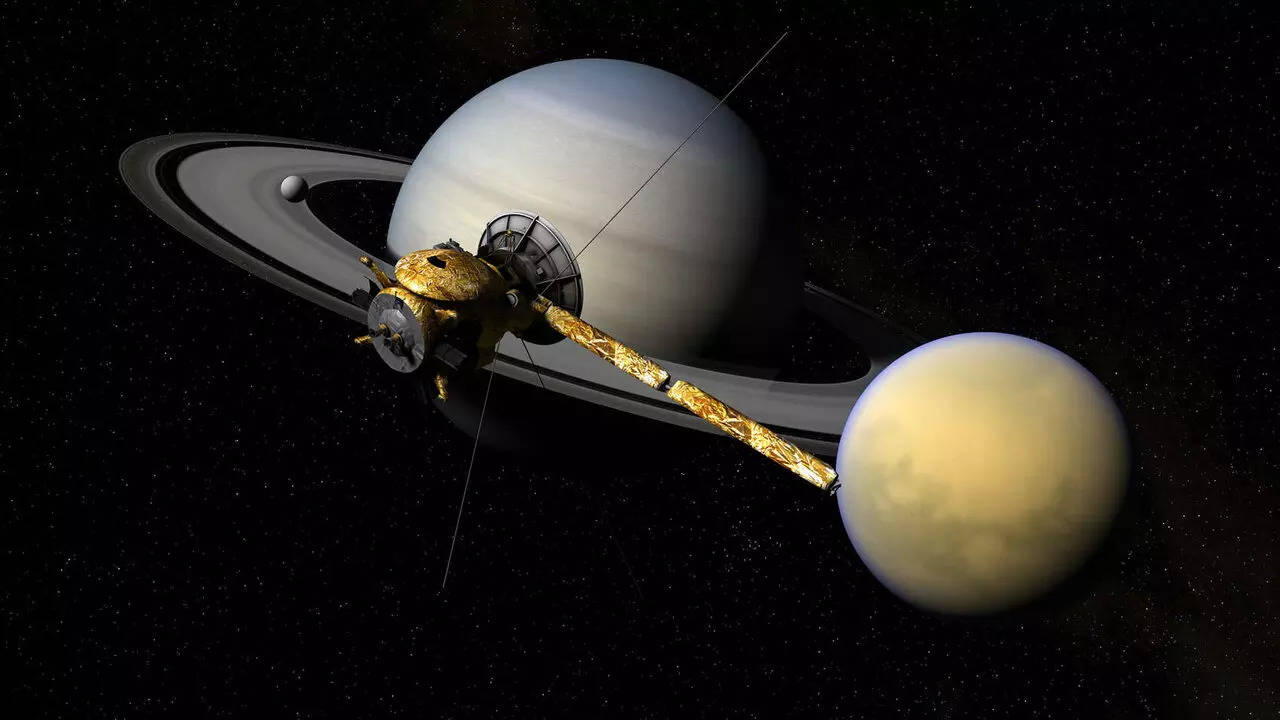[ad_1]
In a recent announcement, NASA disclosed a provisional launch date of July 2028 for its groundbreaking Dragonfly mission, designed to explore Saturn’s largest moon, Titan, reported Space.com. The delay, originally scheduled for 2027, is attributed to budgetary uncertainties surrounding the project.
Despite the setback, the Dragonfly team is advancing to the next developmental phase, Phase C, for the car-sized, nuclear-powered rotorcraft drone.This innovative vehicle is poised to fly above and land on the vast sands of Titan, a moon believed by planetary scientists to be rich in organic molecules.
NASA Science Mission Directorate associate administrator, Nicola Fox, commended the Dragonfly team, stating, “The Dragonfly team has successfully overcome a number of technical and programmatic challenges in this daring endeavor to gather new science on Titan. I am proud of this team and their ability to keep all aspects of the mission moving.”
During NASA’s Outer Planets Assessment Group (OPAG) meeting on Nov. 28, Lori Glaze, director of the agency’s planetary science division, unveiled the reason behind the launch delay. She explained that the formal confirmation, costing, and scheduling of the mission by NASA’s Agency Program Management Council (APMC) had been postponed due to uncertainties in funding for the Financial Year 2024 and Financial Year 2025.
“Because of these incredibly large uncertainties in Financial Year 2024 and Financial Year 2025 funding and budgets, the decision was made at the APMC to postpone the official confirmation,” Glaze stated during the meeting. She added that Dragonfly would be reconsidered in spring 2024 after NASA’s Financial Year 2025 budget proposal.
Once the financial uncertainties are resolved, the Dragonfly team will reevaluate the mission, implementing any necessary restructuring. NASA aims to officially assess the mission’s launch readiness date in mid-2024, leading to some delays in certain elements of Dragonfly’s final mission design and fabrication.
Dragonfly stands out as the sole NASA mission scheduled to visit the surface of an ocean moon. Upon reaching Titan, the drone will investigate conditions that could imply habitability, exploring prebiotic chemistry and searching for signs of water or hydrocarbon-based life.
The Johns Hopkins Applied Physics Laboratory (APL) in Laurel, Maryland, will construct and operate Dragonfly, utilizing its equipped cameras, sensors, and samplers for the investigation. Elizabeth Turtle, Dragonfly principal investigator, expressed her inspiration, stating, “Dragonfly is such a daring endeavor, like nothing that has ever been done before. I’m inspired by the way our team has repeatedly overcome challenges by working together and thinking outside the box.”
Despite the delay, several Dragonfly components, including control and navigation systems, have undergone testing in California deserts and wind tunnels at NASA’s Langley Research Center. A full-scale model has also been tested in Johns Hopkins APL’s Titan Chamber, simulating the harsh conditions of Titan’s methane-rich environment.
“We’ve demonstrated that we’re ready for the next steps on the path to Titan, and we’ll keep moving forward with the same curiosity and creativity that have brought Dragonfly to this point,” concluded Turtle.
Despite the setback, the Dragonfly team is advancing to the next developmental phase, Phase C, for the car-sized, nuclear-powered rotorcraft drone.This innovative vehicle is poised to fly above and land on the vast sands of Titan, a moon believed by planetary scientists to be rich in organic molecules.
NASA Science Mission Directorate associate administrator, Nicola Fox, commended the Dragonfly team, stating, “The Dragonfly team has successfully overcome a number of technical and programmatic challenges in this daring endeavor to gather new science on Titan. I am proud of this team and their ability to keep all aspects of the mission moving.”
During NASA’s Outer Planets Assessment Group (OPAG) meeting on Nov. 28, Lori Glaze, director of the agency’s planetary science division, unveiled the reason behind the launch delay. She explained that the formal confirmation, costing, and scheduling of the mission by NASA’s Agency Program Management Council (APMC) had been postponed due to uncertainties in funding for the Financial Year 2024 and Financial Year 2025.
“Because of these incredibly large uncertainties in Financial Year 2024 and Financial Year 2025 funding and budgets, the decision was made at the APMC to postpone the official confirmation,” Glaze stated during the meeting. She added that Dragonfly would be reconsidered in spring 2024 after NASA’s Financial Year 2025 budget proposal.
Once the financial uncertainties are resolved, the Dragonfly team will reevaluate the mission, implementing any necessary restructuring. NASA aims to officially assess the mission’s launch readiness date in mid-2024, leading to some delays in certain elements of Dragonfly’s final mission design and fabrication.
Dragonfly stands out as the sole NASA mission scheduled to visit the surface of an ocean moon. Upon reaching Titan, the drone will investigate conditions that could imply habitability, exploring prebiotic chemistry and searching for signs of water or hydrocarbon-based life.
The Johns Hopkins Applied Physics Laboratory (APL) in Laurel, Maryland, will construct and operate Dragonfly, utilizing its equipped cameras, sensors, and samplers for the investigation. Elizabeth Turtle, Dragonfly principal investigator, expressed her inspiration, stating, “Dragonfly is such a daring endeavor, like nothing that has ever been done before. I’m inspired by the way our team has repeatedly overcome challenges by working together and thinking outside the box.”
Despite the delay, several Dragonfly components, including control and navigation systems, have undergone testing in California deserts and wind tunnels at NASA’s Langley Research Center. A full-scale model has also been tested in Johns Hopkins APL’s Titan Chamber, simulating the harsh conditions of Titan’s methane-rich environment.
“We’ve demonstrated that we’re ready for the next steps on the path to Titan, and we’ll keep moving forward with the same curiosity and creativity that have brought Dragonfly to this point,” concluded Turtle.
[ad_2]
#Nasa #NASAs #nuclearpowered #mission #Saturns #moon #postponed #due #budget #hurdles

+ There are no comments
Add yours